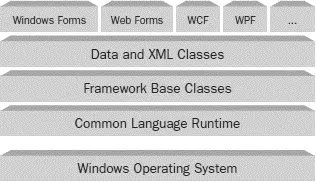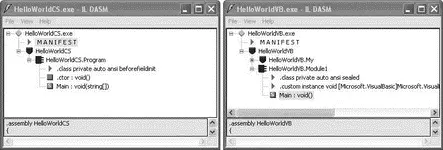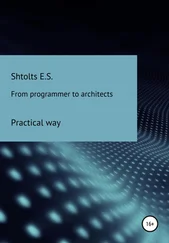The .NET Framework class library is divided into two parts:
□ Framework Class Library (FCL)
□ Base Class Library (BCL)
The BCL is a subset of the entire class library and contains the set of classes that provide core functionalities for your applications. Some of the classes in the BCL are contained in the mscorlib.dll, System.dll, and System.core.dllassemblies. The BCL is available to all the languages using the .NET Framework. It encapsulates all the common functions such as file handling, database access, graphics manipulation, and XML document manipulation.
The FCL is the entire class library and it provides the classes for you to develop all the different types of applications listed previously.
Figure 1-2 shows the key components that make up the .NET Framework.

Figure 1-2
Assemblies and the Microsoft Intermediate Language (MSIL)
In .NET, an application compiled into MSIL bytecode is stored in an assembly. The assembly is contained in one or more PE (portable executable) files and may end with an EXE or DLL extension.
Some of the information contained in an assembly includes:
□ Manifest— Information about the assembly, such as identification, name, version, and so on.
□ Versioning— The version number of an assembly.
□ Metadata— Information that describes the types and methods of the assembly.
Assemblies are discussed in more detail in Chapter 15.
To get a better idea of a MSIL file and its content, take a look at the following example, which has two console applications — one written in C# and the other written in VB.NET.
The following C# code displays the "Hello, World" string in the console window:
using System;
using System.Collections.Generic;
using System.Linq;
using System.Text;
namespace HelloWorldCS {
class Program {
static void Main(string[] args) {
Console.WriteLine("Hello, World!");
Console.ReadLine();
}
}
}
Likewise, the following VB.NET code displays the "Hello, World" string in the console window:
Module Module1
Sub Main()
Console.WriteLine("Hello, World!")
Console.ReadLine()
End Sub
End Module
When both programs are compiled, the assembly for each program has an .exeextension. To view the content of each assembly, you can use the ildasm(MSIL Disassembler) tool.
Launch the ildasm tool from the Visual Studio 2008 Command Prompt window (Start→Programs→Microsoft Visual Studio 2008→Visual Studio Tools→Visual Studio 2008 Command Prompt).
The following command uses the ildasm tool to view the assemblies for the C# and VB.NET programs:
C:\MSIL>ildasm HelloWorldCS.exe
C:\MSIL>ildasm HelloWorldVB.exe
Figure 1-3 shows the content of the C# and VB.NET assemblies, respectively.

Figure 1-3
The Mainmethod of the C# MSIL looks like this:
.method private hidebysig static void Main(string[] args) cil managed {
.entrypoint
// Code size 19 (0x13)
.maxstack 8
IL_0000: nop
IL_0001: ldstr "Hello, World!"
IL_0006: call void [mscorlib]System.Console::WriteLine(string)
IL_000b: nop
IL_000c: call string [mscorlib]System.Console::ReadLine()
IL_0011: pop
IL_0012: ret
} // end of method Program::Main
The Mainmethod of the VB.NET MSIL looks very similar to that of the C# program:
.method public static void Main() cil managed {
.entrypoint
.custom instance void [mscorlib]System.STAThreadAttribute::.ctor() = ( 01 00 00 00 )
// Code size 20 (0x14)
.maxstack 8
IL_0000: nop
IL_0001: ldstr "Hello, World!"
IL_0006: call void [mscorlib]System.Console::WriteLine(string)
IL_000b: nop
IL_000c: call string [mscorlib]System.Console::ReadLine()
IL_0011: pop
IL_0012: nop
IL_0013: ret
} // end of method Module1::Main
The important thing to note here is that regardless of the language you use to develop your .NET applications, all .NET applications are compiled to the MSIL bytecode as this example shows. This means that you can mix and match languages in a .NET project — you can write a component in C# and use VB.NET to derive from it.
Versions of the .NET Framework and Visual Studio
Microsoft officially released the .NET Framework in January 2002. Since then, the .NET Framework has gone through a few iterations, and at the time of writing it stands at version 3.5. While technically you can write .NET applications using a text editor and a compiler, it is always easier to write .NET applications using Visual Studio, the integrated development environment from Microsoft. With Visual Studio, you can use its built-in debugger and support for IntelliSense to effectively and efficiently build .NET applications. The latest version of Visual Studio is Visual Studio 2008.
The following table shows the various versions of the .NET Framework, their release dates, and the versions of Visual Studio that contain them.
| Version |
Version Number |
Release Date |
Versions of Visual Studio shipped |
| 1.0 |
1.0.3705.0 |
2002-01-05 |
Visual Studio .NET 2002 |
| 1.1 |
1.1.4322.573 |
2003-04-01 |
Visual Studio .NET 2003 |
| 2.0 |
2.0.50727.42 |
2005-11-07 |
Visual Studio 2005 |
| 3.0 |
3.0.4506.30 |
2006-11-06 |
Shipped with Windows Vista |
| 3.5 |
3.5.21022.8 |
2007-11-19 |
Visual Studio 2008 |
Starting with Visual Studio 2005, Microsoft dropped the .Net name from the Visual Studio.
The .NET Framework 3.5 builds upon version 2.0 and 3.0 of the .NET Framework, so it essentially contains the following components:
□ .NET Framework 2.0 and .NET Framework 2.0 Service Pack 1
□ .NET Framework 3.0 and .NET Framework 3.0 Service Pack 1
□ New features in .NET 3.5
.NET Framework version 3.5 is dependent on .NET 2.0 and 3.0. If you have a computer with .NET 1.0, 1.1, and 2.0 installed, these three versions are completely separate from each other. When you install .NET 3.5 on a computer without the .NET Framework installed, it will first install .NET 2.0, followed by .NET 3.0, and then finally the new assemblies new in .NET 3.5.
Figure 1-4 summarizes the relationships between .NET 2.0, 3.0, and 3.5.

Figure 1-4
This chapter provided a quick overview of the .NET Framework and the various versions that make up the latest .NET Framework (3.5). Regardless of the language you use, all .NET applications will compile to a bytecode format known as MSIL. The MSIL is then JIT-compiled during runtime by the CLR to generate the native code to be executed by the processor.
Читать дальше















